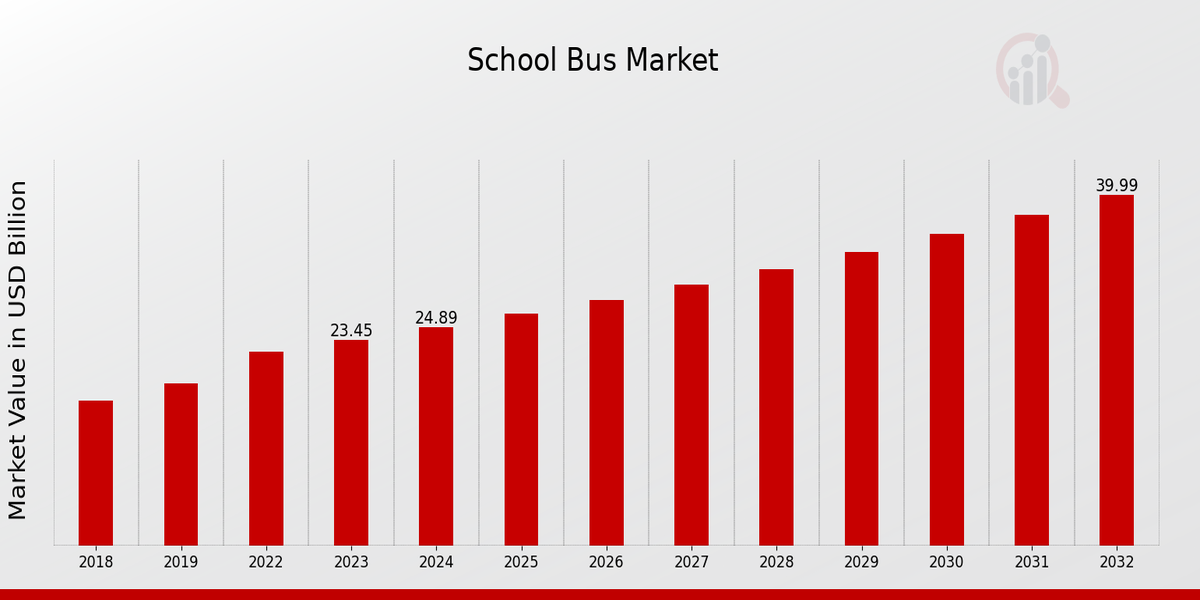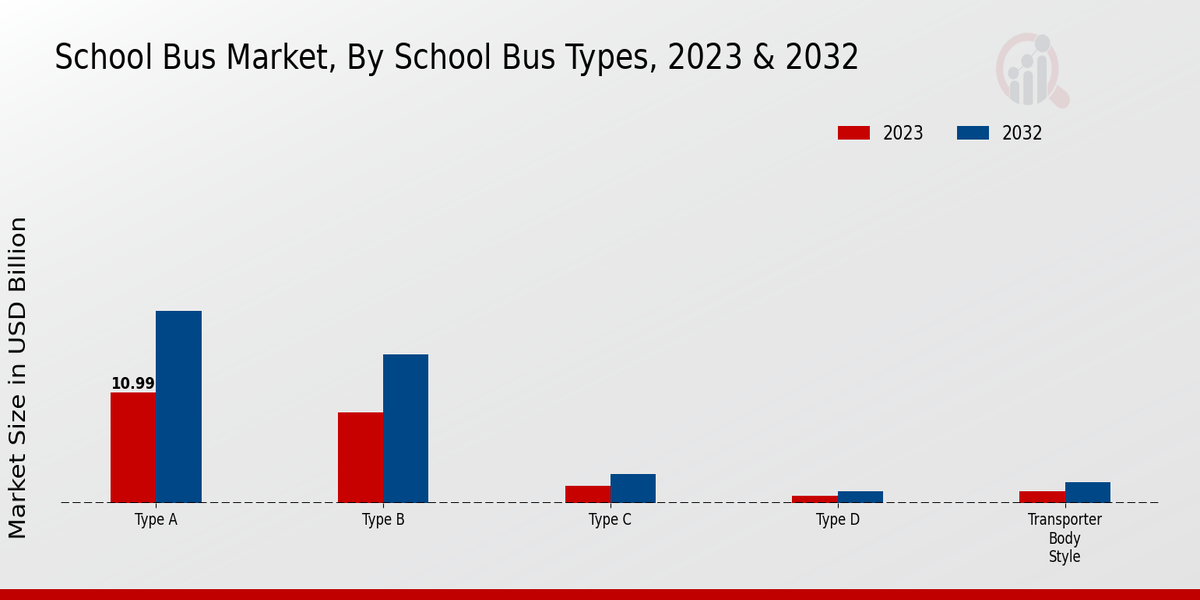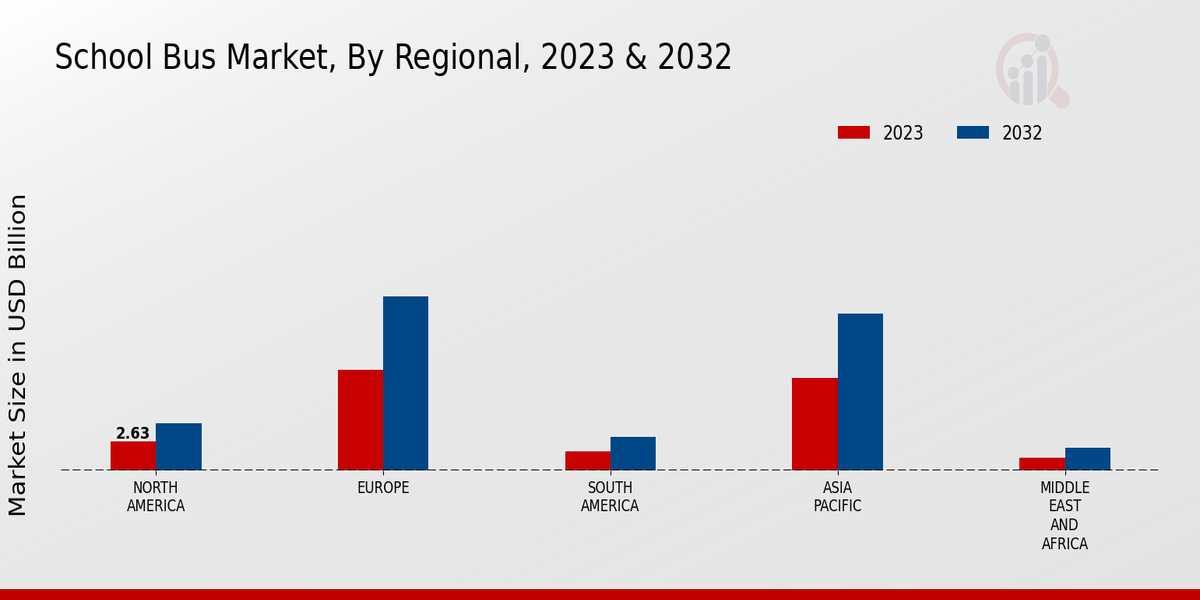School Bus Market Overview
As per MRFR analysis, the School Bus Market Size was estimated at 22.1 (USD Billion) in 2022. The School Bus Market Industry is expected to grow from 23.45(USD Billion) in 2023 to 40.0 (USD Billion) by 2032. The School Bus Market CAGR (growth rate) is expected to be around 6.11% during the forecast period (2024 - 2032).
Key School Bus Market Trends Highlighted
Advanced safety features, technological advancements, and the transition toward electric vehicles are shaping the School Bus Market. The growing emphasis on student safety has led to the integration of advanced driver-assistance systems, such as lane departure warnings and blind spot monitoring, into school buses. Furthermore, the adoption of GPS tracking and telematics systems enhances vehicle efficiency and provides real-time visibility into bus operations.
The rising environmental concerns and the push for sustainable transportation present opportunities for electric school buses. These vehicles offer zero emissions, reducing the carbon footprint of school districts. Governments and organizations are introducing incentives and regulations to promote the adoption of electric school buses, creating lucrative opportunities for manufacturers. Additionally, the trend toward autonomous driving has the potential to revolutionize school bus transportation, improving safety and reducing operational costs.
In recent times, the School Bus Market has witnessed the emergence of new players entering the market, particularly in developing countries. These players are offering cost-effective and localized solutions to meet the growing demand for school transportation. As the market evolves, it is expected to continue experiencing technological advancements, increased focus on safety, and the adoption of environmentally friendly practices.

Source: Primary Research, Secondary Research, MRFR Database and Analyst Review
School Bus Market Drivers
Rising Concerns over Student Safety
The safety and well-being of the students are the major priorities for parents, educators, and policymakers. The school buses provide a reliable and safe mode of transportation, thereby reducing the instances of a student walking or cycling to their school. These buses also comprise advanced safety features such as seat belts, GPS tracking, and emergency communication systems, thereby providing peace of mind to parents and schools. The increasing emphasis on the safety of the students is considered a primary factor fueling the growth of the School Bus Market Industry.
Increasing Government Initiatives and Regulations
Today, governments all over the world pay particular attention to the issues of school bus safety and convenience. There is a tendency to introduce new norms, create new safety zones, and invest in modern school buses. Additionally, governments are interested in the establishment of all the necessary support and subsidy systems, which will help to encourage schools and transport providers to adopt up-to-date technologies and buses. In such a way, they create a rather favorable environment for the further growth of the School Bus Market Industry.
Technological Advancements and Innovation
Technological advancements are revolutionizing the School Bus Market Industry. The integration of GPS tracking systems, real-time monitoring, and mobile applications enhances fleet management efficiency and safety. Schools and transportation providers can track bus locations, monitor student attendance, and communicate with parents and students in real time. Additionally, the development of electric and hybrid school buses reduces operating costs and environmental impact, making them more sustainable and cost-effective options.
School Bus Market Segment Insights
School Bus Market School Bus Types Insights
The School Bus Market is segmented into various categories, one of which is School Bus Types, which comprises Type A, Type B, Type C, Type D, and Transporter Body Style. Type A school buses are the smallest and most common type, with a capacity of up to 30 students. They are typically used for short-distance routes and are popular in rural areas. Type B school buses are larger than Type A buses, with a capacity of up to 60 students. They are often used for longer-distance routes and have more features, such as air conditioning and heating.Type C school buses are the largest and most advanced type of school bus, with a capacity of up to 90 students. They are typically used for long-distance routes and have the most features, such as restrooms and wheelchair lifts. Type D school buses are similar to Type C buses, but they are designed to be more accessible for students with disabilities. They have wider aisles, lower floors, and more secure seating.
Transporter Body Style school buses are not specifically designed for school transportation, but they are often used as school buses in some areas.They are typically used for short-distance routes and have a capacity of up to 30 students. In terms of market share, Type A school buses accounted for the largest share of the School Bus Market revenue in 2023. However, Type C school buses are expected to grow at the highest CAGR during the forecast period due to their increased popularity in urban areas. The growing demand for school buses with advanced safety features is also driving the growth of the Type C school bus market.
Overall, the School Bus Market is expected to grow significantly over the next few years, driven by the increasing demand for safe and reliable transportation for students.The School Bus Types segment is expected to play a major role in this growth, as different types of school buses cater to the specific needs of different schools and communities.

Source: Primary Research, Secondary Research, MRFR Database and Analyst Review
School Bus Market Fuel Type Insights
The School Bus Market is segmented by Fuel Type into Gasoline, Diesel, Electric, Hybrid, and CNG. Among these segments, the Diesel segment is expected to hold the largest market share in 2023, with a valuation of 12.25 Billion USD. However, the Electric segment is projected to witness the fastest growth rate, with a CAGR of 7.1% during the forecast period. This growth can be attributed to increasing government initiatives to promote eco-friendly transportation and rising consumer awareness about environmental sustainability. Electric school buses offer several advantages over traditional fuel-powered vehicles, such as lower operating costs, reduced emissions, and a quieter ride. As a result, the adoption of electric school buses is expected to accelerate in the coming years, driving the growth of the Electric segment in the School Bus Market.
School Bus Market Seating Capacity Insights
The Seating Capacity segment of the School Bus Market exhibits a diverse landscape, catering to the varied transportation needs of schools and educational institutions. The segment comprises five distinct categories: Less than 10, 10-20, 21-30, 31-40, and 40 or more. Each category represents a specific seating capacity range, accommodating different student populations and school bus sizes. The 'Less than 10' category caters to smaller schools or specialized transportation services, while the '40 or more' category accommodates larger schools or long-distance transportation requirements.
Data indicates that the '10-20' seating capacity segment holds a significant market share, driven by the popularity of medium-sized buses that offer a balance of capacity and maneuverability. The '21-30' and '31-40' segments also contribute substantial revenue to the overall School Bus Market, reflecting the demand for larger buses for transporting larger student groups or accommodating special needs students.
School Bus Market Drive System Insights
The drive system segment plays a crucial role in determining the performance and efficiency of school buses. The School Bus Market segmentation by drive system offers insights into the market share, growth prospects, and key trends associated with different drive types. In 2023, the 4x2 drive system dominated the market, accounting for around 60% of the School Bus Market revenue. Its popularity stems from its cost-effectiveness, simplicity, and suitability for urban and suburban applications.
The 4x4 drive system is gaining traction due to its improved traction and off-road capabilities, making it ideal for rural and mountainous regions.Its market share is projected to expand at a CAGR of 5.5% during the forecast period. The 6x4 and 6x6 drive systems are primarily used in heavy-duty school buses and are expected to witness a moderate growth rate over the coming years. The increasing demand for enhanced safety and stability in school buses is driving the adoption of these advanced drive systems.
School Bus Market Safety Features Insights
The School Bus Market is witnessing a surge in demand for advanced safety features to enhance student protection. Advanced Driver Assistance Systems (ADAS) are gaining traction, with features like lane departure warning, adaptive cruise control, and automatic emergency braking becoming increasingly common. Electronic Stability Control (ESC) and Anti-lock Braking System (ABS) have become standard features, contributing to the overall stability and braking performance of school buses. Seatbelts remain crucial for passenger safety, while cameras provide enhanced visibility and surveillance, deterring potential threats. These safety features are not only mandated by regulations in many regions but also highly valued by parents and school districts, leading to their widespread adoption.
School Bus Market Regional Insights
The regional segmentation of the School Bus Market offers valuable insights into the market dynamics across different regions. North America holds a significant share of the market, driven by factors such as stringent safety regulations, increasing student enrollment, and government initiatives promoting school bus transportation.
Europe follows closely, with a well-established school bus industry and a focus on sustainable and innovative solutions. The APAC region, particularly China and India, is expected to witness substantial growth due to rising urbanization, increasing disposable income, and government investments in education infrastructure.South America and MEA present promising opportunities for market expansion as these regions continue to develop their school transportation systems and prioritize student safety. The School Bus Market revenue is projected to reach $26.58 billion by 2024, reflecting a steady growth trajectory driven by these regional trends.

Source: Primary Research, Secondary Research, MRFR Database and Analyst Review
School Bus Market Key Players And Competitive Insights
Major players in the School Bus Market are continuously investing in research and development to introduce advanced technologies and improve the safety and efficiency of their vehicles. They are also expanding their product offerings to cater to the growing demand for specialized school buses, such as electric and propane-powered buses. Leading School Bus Market players are focusing on strategic partnerships and acquisitions to strengthen their market position and gain access to new technologies and markets. School Bus Market development is driven by increasing government regulations and initiatives aimed at improving school bus safety. The industry is also benefiting from the growing adoption of electric school buses, which offer significant environmental and cost-saving benefits.
The competitive School Bus Market Landscape is characterized by a mix of established players and emerging entrants.Blue Bird Corporation is one of the leading School Bus Market players globally. The company offers a wide range of school buses, including conventional, alternative fuel, and electric buses. It has a strong presence in North America and is expanding its operations in international markets. Blue Bird Corporation is known for its focus on innovation and safety, and it has received several awards and recognitions for its products and services.
The company is committed to providing safe, reliable, and efficient school buses that meet the evolving needs of its customers.Thomas Built Buses is another major School Bus Market player with a significant global presence. The company offers a comprehensive range of school buses, including Type A, Type B, and Type C buses. It is known for its commitment to quality and durability, and its buses are widely used by schools and transportation companies worldwide. Thomas Built Buses is continuously investing in research and development to improve the performance and safety of its products. The company is also focused on expanding its product offerings to cater to the growing demand for electric school buses.
Key Companies in the School Bus Market Include
- Mahindra Mahindra
- SAFHolland
- Tata Motors
- Daimler Buses
- Thomas Built Buses
- Girardin Minibus
- Yutong Bus
- VDL Bus Coach
- FAW Jiefang Automobile
- Blue Bird Corporation
- King Long United Automotive Industry
- Ashok Leyland
- IC Bus
- Hino Motors
- Grupo Corvi
School Bus Market Industry Developments
The School Bus Market is projected to reach USD 40.0 billion by 2032, exhibiting a CAGR of 6.11% during the forecast period. Increasing government initiatives to enhance student safety, rising demand for efficient and reliable transportation, and growing urbanization are key factors driving market growth. Recent developments include:- In February 2023, Blue Bird Corporation announced a partnership with Lightning eMotors to develop and produce all-electric school buses.- In March 2023, Thomas Built Buses unveiled its Jouley electric school bus, offering a range of up to 135 miles on a single charge.- Several countries are implementing regulations mandating the use of seat belts and other safety features on school buses.- Governments are also providing incentives and subsidies to promote the adoption of electric and alternative fuel school buses.
School Bus Market Segmentation Insights
School Bus Market School Bus Types Outlook
- Type A
- Type B
- Type C
- Type D
- Transporter Body Style
School Bus Market Fuel Type Outlook
- Gasoline
- Diesel
- Electric
- Hybrid
- CNG
School Bus Market Seating Capacity Outlook
- Less than 10
- 10-20
- 21-30
- 31-40
- 40 or more
School Bus Market Drive System Outlook
School Bus Market Safety Features Outlook
- Advanced Driver Assistance Systems (ADAS)
- Electronic Stability Control (ESC)
- Anti-lock Braking System (ABS)
- Seatbelts
- Cameras
School Bus Market Regional Outlook
- North America
- Europe
- South America
- Asia Pacific
- Middle East and Africa
| Report Attribute/Metric |
Details |
| Market Size 2022 |
22.1(USD Billion) |
| Market Size 2023 |
23.45(USD Billion) |
| Market Size 2032 |
40.0(USD Billion) |
| Compound Annual Growth Rate (CAGR) |
6.11% (2024 - 2032) |
| Report Coverage |
Revenue Forecast, Competitive Landscape, Growth Factors, and Trends |
| Base Year |
2023 |
| Market Forecast Period |
2024 - 2032 |
| Historical Data |
2019 - 2023 |
| Market Forecast Units |
USD Billion |
| Key Companies Profiled |
Mahindra Mahindra, SAFHolland, Tata Motors, Daimler Buses, Thomas Built Buses, Girardin Minibus, Yutong Bus, VDL Bus Coach, FAW Jiefang Automobile, Blue Bird Corporation, King Long United Automotive Industry, Ashok Leyland, IC Bus, Hino Motors, Grupo Corvi |
| Segments Covered |
School Bus Types, Fuel Type, Seating Capacity, Drive System, Safety Features, Regional |
| Key Market Opportunities |
Electrification GPS Tracking Safety Enhancements Ridesharing Subscription-based Models |
| Key Market Dynamics |
Growing government initiatives Rising safety concerns Technological advancements Increasing parental demand Expanding fleet size. |
| Countries Covered |
North America, Europe, APAC, South America, MEA |
Frequently Asked Questions (FAQ) :
The School Bus Market is projected to reach USD 23.45 Billion in 2023.
The School Bus Market is anticipated to grow at a CAGR of 6.11% from 2024 to 2032.
North America is anticipated to dominate the School Bus Market in 2032.
Rising government initiatives for student safety, increasing urbanization, and growing school-age population are driving the School Bus Market.
Key players in the School Bus Market include IC Bus, Blue Bird Corporation, Thomas Built Buses, Daimler AG, and Ashok Leyland.
School buses are primarily used for transporting students to and from school, as well as for field trips and extracurricular activities.
School buses come in various types, including conventional buses, cutaway vans, and electric buses.
School buses are equipped with safety features such as seat belts, flashing lights, stop arms, and emergency exits.
Emerging trends include the adoption of electric school buses, the integration of advanced safety technologies, and the growing popularity of school bus tracking systems.
Challenges include rising fuel costs, competition from ride-sharing services, and the need for improved infrastructure.

















